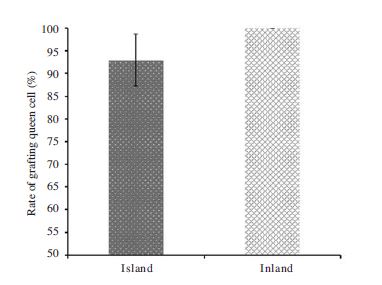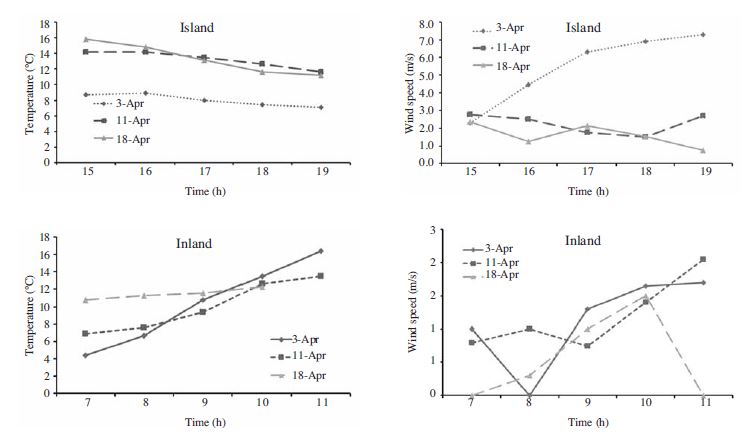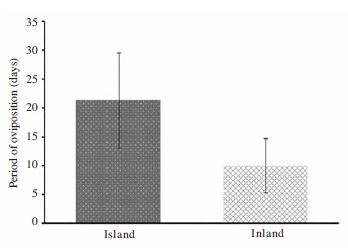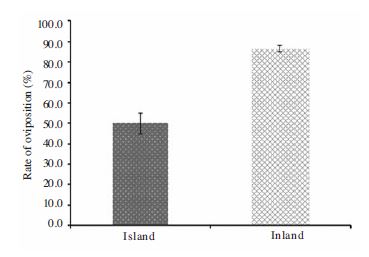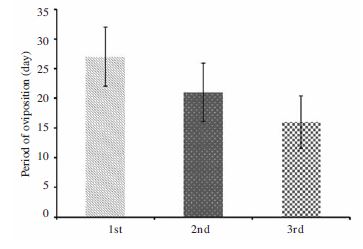
A Comparison of Production Efficiency of Mating Queen Bees Based on Weather Conditions of Island and Inland Areas
The ideal mating season of queen bees and the production efficiency of mating queen bees in island and inland areas were explored on an island called Wido which is 15km away from an inland region. This research was conducted so as to preserve honeybee lineages. In order to compare a mating season of queen bees on an island with that in an inland area, 10 drone colonies, 10 organized queenless colonies, and 60 queen bees were raised. The rates of grafting queen cells, the rates of oviposition, and the priod needed for the first oviposition was examined from March 26th to May 20th. In addition, with a view to find out an ideal mating season of queen bees in an island, 10 drone colonies, 10 organized queenless colonies, and 480 queen bees were raised. The rates of grafting queen cells, the rates of oviposition and the number of days needed for the first oviposition were examined on the basis of daily and monthly weather environments. Because of weather differences between island and inland areas, research on the mating season of queen bees resulted in different rates of grafting queen cells as follows; 93% on the island, and 100% in the inland area. This finding resulted from a lower temperature and stronger winds in an island. The rate of oviposition on the island was 50% and that of the inland area was 86.7%. The priod needed for the first oviposition was 21 days on the island and 10 days in an inland area, respectively, which shows a huge discrepancy between them. The first oviposition dates on the island were all on May 1st, but those in the inland area varied depending on time and seasons. As for the perfect mating season of queen bees, the rates of grafting queen cells were 91% in the first experiment, 96% in the second, and 98% in the third. Meanwhile, the rates of oviposition were 37% in the first, 63% in the second, and 71% in the third, which indicates large differences, depending on maximum temperature and wind speed. The numbers of days needed for the first oviposition were 27 days in the first, 21 days in the second, and 16 days in the third. The later dates of grafting queen cells was getting, the shorter the priod needed for the first oviposition weas. The oviposition dates were all on May 1st, as mentioned above. In conclusion, even though the rate of oviposition on the island was 36% lower than that of the inland area, islands would be better for isolated mating spaces for the purpose of preserving honeybee lineages. According to the findings of these experiments, when islands are used as isolated mating spaces, it is advisable that mating should be done under the following conditions; wind speed less than 1.5m/s, maximum temperature above 20°C and moving hives should be done after April 25th.
Keywords:
Grafting queen, Oviposition, Priod of oviposition, Temperature서 론
꿀벌은 화분매개와 꿀을 생산하는 사회성 곤충으로 우리 인류의 생존과 밀접한 관계에 있다. 최근 지구온난화와 환경오염, 자연교잡 등으로 그 수가 점점 줄어들고 있는 실정(최, 2001)으로 외부 환경에 잘 적응하는 꿀벌의 육종이 절실히 필요하게 되었다.
꿀벌은 집단의 유전적 다양성을 유지하기 위해 다중 교미 진화를 선택했고(Winston, 1936; Woyke, 1973), 처녀여왕벌은 바람 없고 맑은 날의 오전 10시부터 오후 3시 사이에 교미비상을 하여 평균 8~9수벌과 교미한다(김 등, 1996). 꿀벌은 7.5km내에서 90%, 2.5km이내에서는 50% 교미하며, 수벌의 최대 교미거리는 15km이므로(Annette et al., 2005) 원하는 계통의 수벌과 여왕벌이 내륙에서는 자연교배하여 순종을 보존하기 어렵기 때문에 인공수정을 해야 한다(김 등, 1996). 그러나 인공수정을 통한 잡종강세육종을 하면 여왕벌은 변성왕대 형성률이 높아지고, 산란력이 낮으며, 연간 생존율이 31%정도로 낮아(김 등, 1996) 농가에 보급하기 어려운 실정이다.
농가에 보급하기 위해서는 격리지역에서 인공수정을 한 꿀벌을 자연교배를 통해 품종을 보존해야 하는데 국내의 꿀벌밀도는 1km2당 약 18군으로 세계 최대의 밀도를 보이고 있어(FAO, 2013) 내륙에서 15km떨어진 섬을 교미장으로 이용해야 한다. 그래서 섬과 내륙의 기상 환경에 따른 교미 여왕벌 생산 효율 및 섬에서 여왕벌 최적교미시기, 왕대 이식률, 산란율, 첫 산란소요일수를 측정하여 여왕벌의 생리 현상을 관찰하였다.
양봉산업의 지속적인 발전을 위해서는 신품종 여왕벌을 섬에서 안정적으로 대량 양성해서 농가에 보급하는 하는 것이 시급한 과제이므로, 이를 위해 두 지역에서 여왕벌 양성에 기상환경이 어떤 영향을 미치는지 알아보았다.
재료 및 방법
실험재료 및 섬과 내륙의 기상환경 차이
연구의 실험재료는 예천군곤충연구소 양봉장에서 육종되는 Apis mellifera의 신품종 원원종을 사용하고, 2014년 3월 26일부터 5월 20일까지 여왕벌 양성 실험을 3회 수행하였다.
내륙의 양봉장은 경상북도 예천군 풍양면 청곡리이며 위치는 동경 128°, 북위 36°로 연평균 기온은 12.2°C이고 평균 강수량은 1,120mm정도이다.
섬의 양봉장은 전라북도 부안군 위도면 진리이며 위치는 동경 126°, 북위 35°로 해양성 기후를 나타내고 연평균 기온은 12.6°C이며 평균 강수량은 1,250.4mm이다.
여왕벌과 수벌 양성 및 관리
여왕벌은 인공왕대를 이용해서 부화 1일이하의 어린 유충을 이충하여 왕대를 만들었으며 이식시기에 맞추어 사군교미전용벌통에 교미 핵군을 편성해서 왕대 유입 5시간 전 섬 격리교미장으로 이송시켜 왕대 유입하였다.
출방한 수벌의 교미 성숙 시기와 처녀여왕벌의 교미비상시기를 동일하게 해서 교미할 수 있도록 여왕벌 양성의 3회 이충 기준일 20일 전부터, 부군 봉군에 수벌을 양성하였다(윤등, 2008).
교미 핵군은 벌통의 세력을 동일한 조건으로 섬에서는 사군교미전용벌통(30통)을, 내륙은 일반벌통(30통)에 편성하였다.
왕대 이식률 및 산란율, 첫 산란 소요일수 조사
왕대 이식률은(신여왕벌수/총왕대이식수×100)으로 산정하였고, 이식일은 1차(4월 3일), 2차(4월 11일), 3차(4월 18일)로 3회 수행하였다. 산란율은(산란여왕수/신여왕벌수×100)으로 측정하였고, 첫 산란소요일수는 왕대를 이식한 다음 날로부터 첫 산란일까지 소요된 일수를 기록하였다.
결과 및 고찰
섬과 내륙의 교미 여왕벌 비교
섬에서 왕대 이식률은 1차시기(8.4°C, 5.5m/s)일 때 90%, 2차시기(13.5°C, 2.2m/s)는 90%, 3차시기(12°C, 1.6m/s)는 100%로평균93%를 나타났다(Fig. 1, Fig. 2).
내륙은 1차시기(13.5°C, 1.7m/s) 100%, 2차시기 (12.6°C, 1.4m/s) 100%, 3차시기(12.3°C, 1.5m/s)는 100% 로평균100%를 나타났다(Fig. 1, Fig. 2).
본 실험에서 특이한 점은 섬이 2차시기에 기온이 높고 풍속이 약했지만 왕대 이식률이 90%가 나타났고, 내륙지역은 2차시기 9시경에 기온이 10°C 이하로 내려갔음에도 왕대 이식률이 100%로 나타났다. 이에 대한 추가적인 분석과 시험이 요구된다.
첫 산란소요일수는 여왕벌이 출방일로부터 첫 산란일까지의 소요되는 일수이다. 여왕벌은 출방 후 7~10일 안에 교미하는 것이 일반적이고 교미 후 2~3일 안에 첫 산란을 하며 (김 등, 1996), 출방 후 첫 산란에 소요되는 일수는 9~13일로 추정할 수 있다.
첫 산란소요일수는 섬이 1차(18.6°C, 3.9m/s) 27일, 2차(18.6°C, 3.9m/s) 21일, 3차(15.3°C, 1.0m/s) 16일 나타났고, 내륙은 1차(25.2°C, 1.7m/s) 12일, 2차(22.5°C, 1.5m/s) 10일, 3차(22.8°C, 1.1m/s) 8일 나타났다. 섬은 평균 21일, 최소 12일, 최대 33일이고, 내륙은 평균 10일, 최소 7일, 최대 13일이다(Fig. 3). 섬은 첫 산란소요일수가 추정일보다 길고, 내륙은 추정일 이내로 나왔다. 표준편차는 섬이 2.1일, 내륙은 8.3일로 약 4배 차이를 나타냈다.
산란율
산란율은 섬이 평균 50%로 1차시기(18.6°C, 3.9m/s) 30%, 2차시기(18.6°C, 3.9m/s) 50%, 3차시기는(15.3°C, 1.0m/s) 70%를 나타났고, 내륙은 평균 86.7%로 1차시기(25.2°C, 1.7m/s) 90%, 2차시기(22.5°C, 1.5m/s) 100%, 3차시기(22.8°C, 1.1m/s)는 100%를 나타났다(Fig. 4).
5월 2일 전후에 첫 산란여왕벌수가 많이 나타난 것은 섬에서 4월 26일(21.4°C, 1.3m/s)에서 4월 28일(20.8°C, 1.3m/s)에 3일간 낮 최고기온이 20℃이상 상승하여첫산란여왕벌수가가장많이나타났다(Fig. 5).
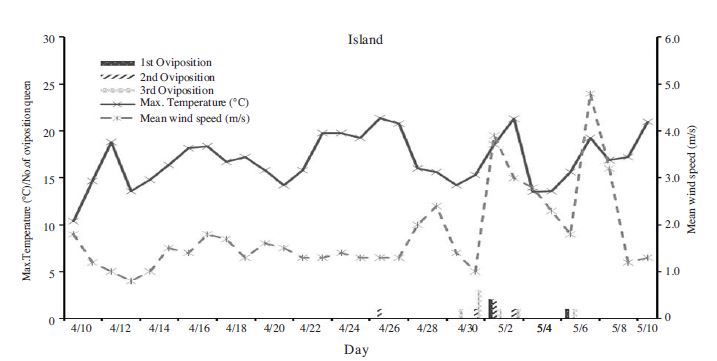
The number of oviposition queen by maximum temperature and wind speed of date in the island of Apis mellifera.
내륙은 4월 10일(22.5°C, 1.1m/s)부터 낮 최고기온이 20°C이상 올라간 일수가 많아 1차시기 4월 14일, 2차시기 4월 22일, 3차시기 4월 26일을 중심으로 산란일이 분산되어 나타났다(Fig. 6).
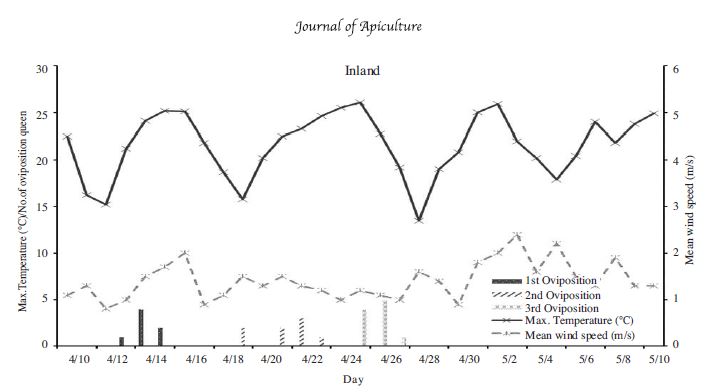
The number of oviposition queen by maximum temperature and wind speed of date in the inland of Apis mellifera.
본 실험 결과는 섬이 내륙보다 첫 산란소요일수가 10일 길고, 산란율은 13.3%로 낮게 나타나 섬이 내륙보다 여왕벌 교미시기가 늦다는 것을 알 수 있다.
섬에서 여왕벌 최적교미시기
1차 왕대이식일(4월 3일) 온도는 8.4°C로 낮았고, 바람이 5.5m/s로 강하게 불어 2차(13.5°C, 2m/s)와 3차(12°C, 2m/s)시기에 비해 상대적으로 기상여건이 불리했다(Fig. 7)
왕대 이식일의 기상 차이로 왕대 이식률은 1차(4월 3일) 91%, 2차(4월 11일) 96%, 3차 (4월 18일) 98%로 나타났다(Table 1).

The correlation coefficient by rate of grafting queen cell, temperature, wind speed in the island of Apis mellifera
본 실험을 통해 섬에서 왕대 이식률과 기상환경의 상관관계를 알아보면 온도는 0.85, 풍속은 -0.81로 유의성이 있는 것으로 나타났다(Table 2). 따라서 왕대 이식률은 왕대 이식 시 섬의 기상조건 중 온도와 풍속이 여왕벌 출방에 영향을 끼치는 것으로 생각된다.
1차시기의 첫 산란소요일수는 평균 27일, 최소 16일, 최대 34일이고, 2차시기의 경우 평균 21일, 최소 14일, 최대 32일이며, 3차시기는 평균 16일 최소 7일, 최대 27일로 나타났다(Fig. 8).
일반적인 첫 산란소요일수의 추정일은 9~13일이며, 여왕벌 출방 후 약 21일이 경과되면 교미가 극히 드물게 이루어진다(김 등, 1996)라고 할 때, 본 연구에서는 출방 후 전체 평균 21일에, 최대 34일까지도 산란이 이루어졌다.
산란율은 1차 37%, 2차 63%, 3차 71%로 나타나 실험후기로 갈수록 산란율이 높아지는 경향을 볼 수 있었다(Table 3).
1차 시기에는 4월 19일(17.2°C, 1.3m/s) 11.1%가 첫산란을 하여, 전체 산란율 37% 중 5월 1일(15.3°C, 1.0m/s) 26마리로 36.1%의 가장 높은 산란율을 보였으며, 가장 늦은 산란은 5월 7일(19.3°C, 4.8m/s)에 나타났다.
2차에서는 4월 25일(19.3°C, 1.3m/s)에 첫 산란하여 전체 산란율 63% 중 5월 1일(15.3°C, 1.0m/s)에 27.8%로 가장 높게 나타났다.
3차시기는 4월 25일(19.3°C, 1.3m/s)에 첫 산란하여 전체 산란율 71% 중 5월 1일(15.3°C, 1.0m/s)에 32.4%로 가장 높게 나타났다.
양봉꿀벌의 교미에 적당한 날씨는 낮 최고기온 20°C 이상 구름이 없고, 풍속은 5.5~7.7m/s 이하일 때 주로 이루어진다(Ruttner et al., 1972; Winston, 1987)는 것을 볼 때 섬에서 1차로 유입된 신여왕벌군의 교미 시기인 4월 10일에서 4월 20일 사이의 낮 최고 기온이 대부분 18°C 이하로 떨어져 교미가 적기에 이루어지지 않아 산란율이 낮아진 것으로 사료되고(Fig. 9), 2, 3차 실험은 기후조건이 좋아짐에 따라 교미가 정상적으로 이루어져 산란율이 높아졌다고 생각된다.
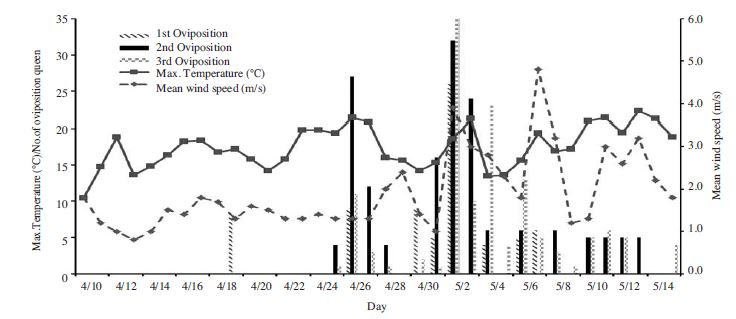
The number of oviposition queen by maximum temperature and wind speed of date in the island of Apis mellifera
본 실험 결과 섬의 여왕벌 교미 최적기상조건은 낮 최고기온 20°C 이상, 풍속 1.0~1.3m/로 나타났다. 위도지역을 격리교미장으로 이용하고자 하는 경우 연도별 기상의 차이는 있지만 여왕벌의 교미시기를 4월 25일 이후에 벌통을 옮겨 교미를 시키는 것이 좋을 것으로 생각된다.
적 요
섬과 내륙지역의 교미 여왕벌 생산 효율을 알아보기 위해 일별 및 월별 기상 환경에 따른 왕대 이식률, 산란율, 첫 산란소요일수를 조사하였다.
섬과 내륙의 기후변화에 따른 여왕벌 교미시기를 조사한 결과 섬이 내륙보다 첫 산란소요일수가 10일 길고, 산란율은 13.3%로 낮게 나타나 섬이 내륙보다 여왕벌 교미시기가 늦다는 것을 알 수 있다.
섬에서의 여왕벌 최적교미시기를 조사한 결과 섬의 여왕벌 교미 최적기상조건은 낮 최고기온 20℃ 이상, 풍속 1.0~1.3m/로 나타났다. 위도지역을 격리교미장으로 이용하고자 하는 경우 연도별 기상의 차이는 있지만, 4월 25일 이후에 벌통을 옮겨 교미를 시키는 것이 좋을 것으로 생각된다.
국내의 다른 섬을 이용할 경우 기상 환경을 분석한 후 여왕벌 최적 교미시기에 맞추어 여왕벌 양성을 실행해야 한다.
Acknowledgments
본 연구는 농촌진흥청 아젠다 연구사업“우수계통 선발종의 농가실증 및 적용기술 개발(과제번호: PJ008266)”에 의하여 수행되었다.
References
- 기상청, (2014), 기상청홈페이지(http://kma.go.kr)지역별상세 관측자료/연·월보 자료/방재기상연월보.
- 김병호, 등 , (1996), 최신양봉학, 선진문화사, 41, p165-210.
- 윤형주, 등 , (2008), 곤충의 인공수정법, 농촌진흥청 농업과학 기술원 농업생물부, p43.
- Annette, B., Jensen Kellie, A. Palmer, Nicolas Chaline, Nigel E. Raine, Adam, Tofski, Martin, Stephen J., Bo V. Pedersen, Jacobus J. Boomsma, and Francis L.W. Ratnieks, (2005), Quantifying honey bee mating range and isolation in semi-isolated valleys by DNA microsatellite paternity analysis, Conservation Genet, 6, p527-537.
- Food and Agriculture Organization of the United Nations(FAO), (2013), FAO Homepae (http://www.fao.org) Statistics/Databases/FAOSTAT/Production/Live Animals.
-
Winston, E.O., (1963), Social modifications related to rareness in ant species, 17, Evolution, p249-253, 1971 The Insect Societies Cambridge, Mass.: Harvard Univ. Press.
Woyke, J., (1973), Reproduction in Apis cerana 1, Mating behavior. J. Apic. Res, 11(3), p141-146. - Winston, M.L., (1987), The biology of the honey bee, p203.
